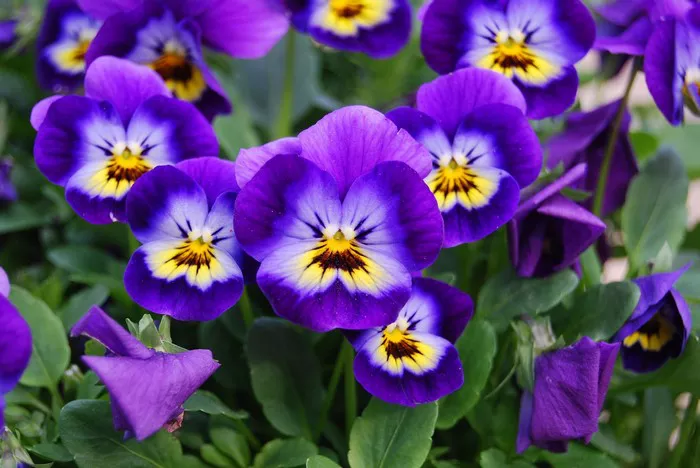In recent years, the culinary world has witnessed a resurgence of interest in edible flowers, with chefs and home cooks alike incorporating these colorful blooms into their dishes. Among the myriad of options, Viola flowers stand out for their delicate appearance and subtle flavor. But can you really eat Viola flowers? In this article, we’ll delve into the edibility, nutritional value, and provide delectable recipes featuring these charming blossoms.
Edibility of Viola Flowers
Viola flowers, commonly known as violets, pansies, or violas, are indeed edible. However, it’s essential to ensure that the flowers you intend to consume are grown organically and haven’t been treated with pesticides or other chemicals. Viola flowers are typically harvested in the spring when they are at their peak freshness and flavor.
When choosing Viola flowers for consumption, opt for those with vibrant colors and firm petals. Avoid flowers that appear wilted or have blemishes, as they may not be suitable for consumption. It’s also recommended to wash the flowers gently before use to remove any dirt or debris.
While Viola flowers are generally safe to eat, it’s crucial to exercise caution and moderation, especially if you have allergies or sensitivities to certain plants. As with any new food, it’s advisable to consume Viola flowers in small quantities initially to gauge your body’s reaction.
Nutritional Value of Viola Flowers
Beyond their aesthetic appeal, Viola flowers offer a surprising array of nutritional benefits. These delicate blooms are rich in vitamins, minerals, and antioxidants, making them a valuable addition to any diet.
One of the standout nutritional components of Viola flowers is their high vitamin C content. Vitamin C is essential for immune function, collagen synthesis, and antioxidant defense. Incorporating Viola flowers into your meals can help boost your body’s vitamin C intake and support overall health.
Additionally, Viola flowers contain significant levels of vitamin A, which is vital for vision health, immune function, and skin health. Vitamin A plays a crucial role in maintaining healthy mucous membranes, which serve as a barrier against infections.
Furthermore, Viola flowers boast antioxidant compounds such as flavonoids and anthocyanins, which help protect cells from oxidative damage caused by free radicals. These antioxidants contribute to reducing inflammation, lowering the risk of chronic diseases, and promoting overall well-being.
In terms of minerals, Viola flowers provide small amounts of potassium, calcium, and magnesium, which are essential for various bodily functions, including muscle and nerve function, bone health, and electrolyte balance.
Overall, Viola flowers offer a nutrient-dense addition to your diet, providing a burst of flavor along with numerous health benefits.
Delicious Recipes Featuring Viola Flowers
Now that we’ve explored the edibility and nutritional value of Viola flowers, let’s delve into some delightful recipes that showcase these charming blooms.
1. Viola Flower Salad
Ingredients:
- Fresh Viola flowers
- Mixed salad greens (such as spinach, arugula, and kale)
- Cherry tomatoes, halved
- Cucumber, sliced
- Red onion, thinly sliced
- Feta cheese, crumbled
- Balsamic vinaigrette dressing
Instructions:
- Rinse the Viola flowers and salad greens thoroughly and pat dry.
- In a large salad bowl, combine the mixed greens, cherry tomatoes, cucumber, and red onion.
- Garnish the salad with fresh Viola flowers and crumbled feta cheese.
- Drizzle balsamic vinaigrette dressing over the salad and toss gently to coat.
- Serve immediately and enjoy the vibrant colors and flavors of this Viola flower salad.
2. Viola Flower Infused Honey
Ingredients:
- Fresh Viola flowers
- Raw honey
Instructions:
- Pluck the Viola flowers from the stems, ensuring they are clean and free of debris.
- Fill a clean, dry jar with the Viola flowers, packing them gently.
- Pour raw honey over the Viola flowers until they are completely submerged.
- Seal the jar tightly and let it sit at room temperature for 1-2 weeks to allow the flavors to infuse.
- Strain the infused honey through a fine-mesh sieve to remove the flowers.
- Transfer the strained honey to a clean jar and store it in a cool, dark place.
- Use Viola flower infused honey as a sweetener for teas, desserts, or drizzled over yogurt or fruit.
3. Viola Flower Lemonade
Ingredients:
- Fresh Viola flowers
- Lemons
- Sugar or honey
- Water
Instructions:
- Prepare a simple syrup by combining equal parts sugar (or honey) and water in a saucepan. Heat over medium heat, stirring until the sugar is completely dissolved. Remove from heat and let cool.
- Juice the lemons to obtain fresh lemon juice.
- Pluck the Viola flowers from the stems, discarding any green parts.
- In a large pitcher, combine the lemon juice, simple syrup, and water to taste.
- Add the Viola flowers to the pitcher and stir gently.
- Refrigerate the Viola flower lemonade for at least an hour to allow the flavors to meld.
- Serve the lemonade over ice, garnished with additional Viola flowers for a visually stunning presentation.
These recipes offer just a glimpse of the culinary possibilities that Viola flowers offer. Feel free to experiment and get creative with incorporating these delightful blooms into your favorite dishes and beverages.
Conclusion
In conclusion, Viola flowers are not only visually appealing but also nutritious and versatile in the kitchen. Whether used as a garnish for salads, infused into honey, or incorporated into refreshing beverages, Viola flowers add a touch of elegance and flavor to any culinary creation. So go ahead, embrace the beauty of Viola flowers, and elevate your culinary repertoire with these delightful blooms.


